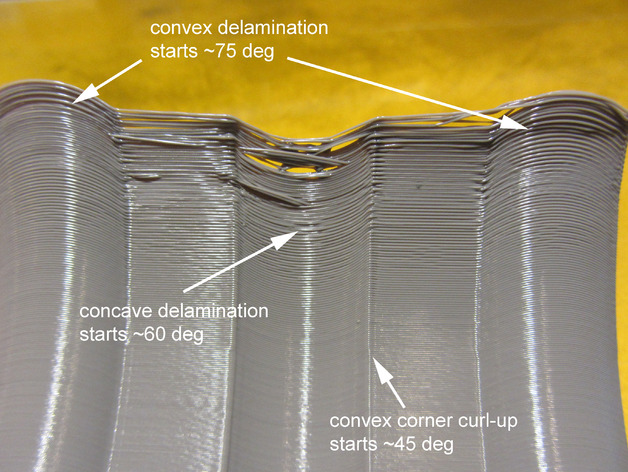
Convex/Concave/Straight Overhang Test
thingiverse
Not all overhangs are created equal in terms of print quality. The quality depends not only on the overhang angle but also on whether the overhang surface is convex, concave, straight, or a sharp corner. This test part showcases all these variations. The overhang angle starts at 15 degrees and goes up to 80 degrees with graduated markings at 30, 45, 60, and 75 degrees. Types of Print Degradation There are two types of print surface degradation that occur with overhangs: Convex curves (from smooth curves to sharp corners) tend to curl up due to the filament being stretched as it is laid down. If not connected to much below, this stretch causes the filament to curl up. The sharper the radius, the more the curl, and the greater the overhand angle, the more the curl. Concave curves tend to delaminate horizontally because the filament is stretched as it goes down, causing a "shortcut" if there isn't enough below to stick to. Straight overhangs are not affected by stretch (like bridging), but eventually, the filament will delaminate horizontally because the layers have nothing below them to squish and widen the line enough to attach to the adjacent line. To improve overhang performance, try playing with layer thickness and line width. Thicker layers where the line width is close to the thickness require less stretching of the filament. However, from a practical standpoint, it's usually better to play with extrusion temperature and airflow. I tend to follow the Makerbot Replicator 2 methodology of printing PLA very hot (230 degrees) and with a lot of airflow (I use a ducted blower instead of a fan). The high temperature reduces internal extruder pressure and ensures good adhesion with the layer below. High airflow cools the filament quickly, allowing less time for stretching to deform the surface. I look forward to people's comments about what they've found successful.
With this file you will be able to print Convex/Concave/Straight Overhang Test with your 3D printer. Click on the button and save the file on your computer to work, edit or customize your design. You can also find more 3D designs for printers on Convex/Concave/Straight Overhang Test.
